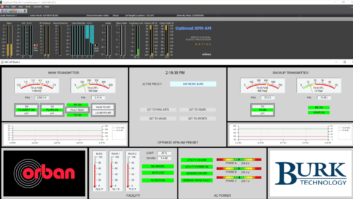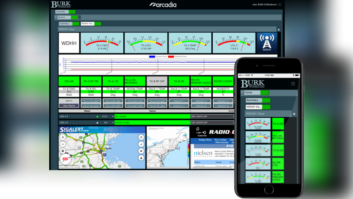LARAMIE, Wyo. — The first remote control system I can remember working with was a Rust system that used a stepper relay and would tie to its remote counterpart at the transmitter site over a Mountain Bell DC loop circuit. When I think about where we are now with remote monitoring, it’s truly amazing.
The latest product I have been using at Wyoming Public Radio is the Burk ARC Solo. It is a remote control unit with everything I need in one box.
PROGRAMMABLE

The ARC Solo is a 2 RU black box with only one button on the front (local/remote) and two lights (remote and alarm). The back of the unit has all the interconnection terminals for relay control, metering and status. There are 16 relay channels available. They can be configured as eight lower and eight raise or 16 raise or 16 lower. The user chooses the configuration via the GUI.
The ARC Solo provides 16 metering channels (–10 VDC to +10 VDC) and 16 status channels (DC voltage or switch closure). Since these are all on the back via compact Phoenix connectors, this means no more dangling ribbon cables or 3 RU relay panels. I always hated my remote control unit taking up half the equipment rack.
The only other connectors on the back are the power connector, the RJ-11 telco connector (we don’t use this, but it’s nice to have available), an RJ-45 Ethernet connector and two RCA phono jacks (audio-in and audio-out). Audio monitoring is available via the telco connection. I would love to have it streamed over IP too.
The ARC Solo has a true HTML5-capable Web GUI built into the unit. The main screen is the “channels” screen. This page is simple and to the point. It is easy to understand and easy to identify problems. I don’t need cute representations of meters and gauges and buttons and dials. This is 2015, folks.
There are three columns: one each for “metering,” “status” and “commands.”
The metering column gives you the meter reading and a colored dot. The colored dot can indicate a “good,” “concerning” or an “alarming” situation for each channel. Users program the thresholds of each alert. Users can even select the color. I just used the standard green, yellow and red. Users can also set the unit to send attention notifications notify by email when a channel reaches a certain programmable threshold (low or high).
For status, users set the dot color parameters and the status “value” name can change upon condition change. Alarm notifications can also be set for status changes.
The command column is a little different. As explained above, users can set up their own raise versus lower layout. I normally just set all channels for “raise” because many devices aren’t strictly on and off.
The “Jet” commands are for scripting items to happen. I haven’t used them much with Wyoming Public Radio; however I have used them for pattern and power changes for AM stations. They work well. Burk’s AutoPilot is used to create the Jet flowcharts. Users do not need to purchase a license to use this part of AutoPilot, but it would be convenient if Jet flowcharts could be directly set up through the Web GUI.
The “system” area is where all the setup for the unit occurs. I won’t go into much detail as this would take up much more space and time than necessary. However, I will say that navigating the menus in this area is straightforward. This area is used for setting up the layout of the channels page, alarm thresholds, email alert setup, firmware upgrades, phone lists, meter calibration, users, time and calendar and much more.
At Wyoming Public Radio, we operate 26 transmit facilities around the state including translators. At transmitter sites we use ARC Solo to control the transmitters and to perform other functions like monitoring rack and room temperatures and checking the voltage coming into the building and coming off the UPS. We can also use the ARC Solo to reboot the exporter, saving a trip to the transmitter site. At translator sites we don’t need the power of the ARC Solo, so we take a different approach.
Overall, I have found the ARC Solo to be the perfect unit at WPR sites. So far we have deployed about seven units and plan to install about eight more over the next year.
For information, contact Burk Technology in Massachusetts at (978) 486-0086 or visit www.burk.com.












